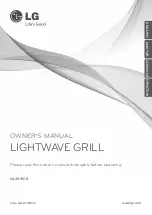
6
products, etc. to come in contact with plastic
parts. These materials contain chemicals that can
damage, weaken, or destroy plastic.
8.
An extension cord should not be used unless
absolutely necessary. Use of an improper
extension cord could result in a risk of fire and
electric shock. If an extension cord must be
used, make sure that:
The pins on plug of extension cord are the
same number, size and shape as those of the
plug on charger.
The cord is properly wired and in good
electrical condition
9.
Do not operate the charger with a damaged
cord or plug, which could cause shorting and
electric shock. If damaged, have the charger
repaired or replaced by an authorized service
technician at
Service Center.
10.
Do not operate the charger if it has has
otherwise been damaged in any way. Take it
to an authorized service technician at
Service Center for an electrical check to
determine if the charger is in good working
order.
11.
Do not disassemble the charger. Take it to
an authorized service technician at a
Service Center when service or repair is
required. Incorrect reassembly may result in a
risk of electric shock or fire.
12.
Unplug the charger from the electrical
outlet before attempting any maintenance or
cleaning to reduce the risk of electric shock.
13.
Disconnect charger from the power supply
when not in use. This will reduce the risk of
electric shock or damage to the charger if
metal items should fall into the opening. It
will also help prevent damage to the charger
during a power surge.
14.
Risk of electric shock. Do not touch the
uninsulated portion of output connector or
uninsulated battery terminal.
ADDITIONAL SAFETY RULES
FOR DRILLS
1. Hold power tools by insulated gripping
surfaces when performing an operation where
the cutting tool may contact hidden wiring or
its own cord. Contact with a “live” wire will
also make exposed metal parts of the tool
“live” and shock the operator.
2. Use auxiliary handle supplied with the tool.
Loss of control can cause personal injury.
3. Use clamps or another practical way to
secure and support the workpiece to a stable
platform.Holding the work by hand or against
your body leaves it unstable and may lead to
loss of control.
4. Know your power tool. Read operator’s
manual carefully. Learn its applications and
limitations, as well as the specific potential
hazards related to this tool. Following this rule
will reduce the risk of electric shock, fire or
serious injury.
5. Hold the power tool with a firm grip. High
reaction torque can briefly occur while driving
in and loosening screws.
6. Always wear safety glasses with side shields.
Everyday glasses have only impact resistant
lenses. They are NOT safety glasses.
Following this rule will reduce the risk of eye
injury.
7. Protect your lungs. Wear a face or dust mask
if the operation is dusty. Following this rule will
reduce the risk of serious personal injury.
8. Protect your hearing. Wear hearing protection
during extended periods of operation.
Following this rule will reduce the risk of
serious person injury.
9. Battery tools do not have to be plugged into
an electrical outlet; therefore, they are always
in operating condition. Be aware of possible
hazards when not using your battery tool or
when changing accessories. Following this
rule will reduce the risk of electric shock, fire
or serious personal injury.
10. Do not place battery tools or their batteries
near fire or heat. This will reduce the risk of
explosion and possibly injury.
11. Do not crush, drop or damage battery pack.
Do not use a battery pack or charger that
has been dropped or
Summary of Contents for DD1813
Page 17: ...17...
Page 18: ...18 1 2 Chuck Cordless Drill ltem No DD18132A...
Page 20: ...20 1 2 Chuck Cordless Hammer Drill ltem No DH18262A...
Page 39: ...17...
Page 40: ...18 1 2 Chuck Cordless Drill ltem No DD1813...
Page 42: ...20 1 2 Chuck Cordless Hammer Drill ltem No DH1826...
















































